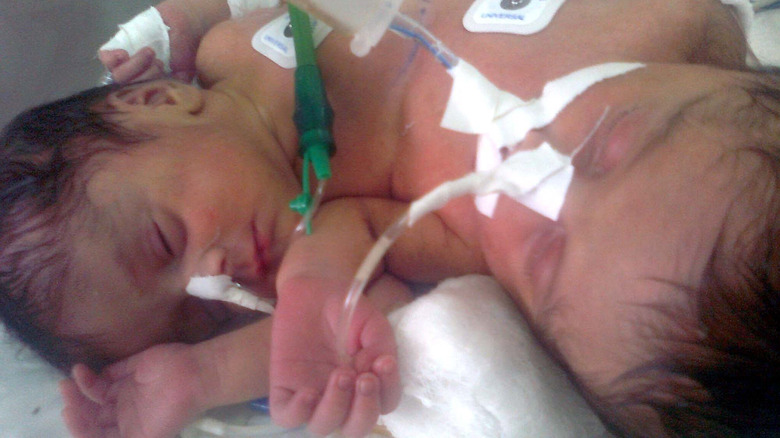How Rare Are Conjoined Twins?
Twins whose bodies are physically attached are referred to as conjoined twins (via WebMD). With identical twins, a single fertilized egg splits into two embryos. In rare instances, this separation isn't complete, resulting in the development of conjoined twins. Scientists still don't fully understand how this happens.
Conjoined twins typically are detected and evaluated in the early stages of pregnancy, through prenatal imaging tests including ultrasound, fetal echocardiogram, and ultrafast fetal MRI (via Children's Hospital of Philadelphia). Not all conjoined twins are connected in the same way. Three-quarters of conjoined twin cases involve attachment at the chest or upper abdomen. In these cases, the twins are facing one another and share a sternum, diaphragm, and upper abdominal wall. They usually share a heart and maybe a liver (via WebMD).
About 20% of conjoined twins are connected at the buttocks and perineum and face away from each other. The least common occurrence, making up 2% of cases, is conjoined twins whose skulls are fused (via Children's Hospital of Philadelphia).
Medical needs of conjoined twins following birth
Occurring once in every 50,000 to 60,000 births (via Children's Hospital of Philadelphia), conjoined twins are considered to be exceedingly rare (via WebMD). The majority of cases are seen in female twins, and over half are born stillborn or miscarried.
Conjoined twins require delivery by C-section, and special care immediately following birth (via WebMD). Surgical separation may be an option if doctors determine the twins to be candidates for the procedure. While immediate separation surgery following birth is sometimes required, in cases of elective separation surgery, the procedure may take place anywhere from three months to a full year after birth to give doctors time to fully monitor the twins' development. Dr. Granger Wong, the lead plastic surgeon at UC Davis Children's Hospital overseeing the case of 9-month-old conjoined twins Abigail and Micaela in 2020, explained their medical team's decision to conduct surgery no longer than nine months following birth, stating, "As they get older, there are more risks of shared blood vessels and organs becoming larger or more entwined."
For conjoined twins who undergo separation surgery, follow-up physical and occupational therapy is often required (via WebMD). For those who do not undergo surgery, additional support for day-to-day activities may be needed.


